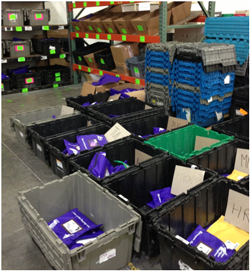Top Five Reasons for Delayed Items
 TAE participants do a great job of sending items through the service. For the month of October, out of 57,088 items reported sent, only 82 were misdirected to the TAE office due to labeling issues. That’s less than 2% of items sent through the system! Of course that doesn't ease the frustration you feel when it's your item that's been delayed, so I've compiled the top reasons that items get misdirected.
TAE participants do a great job of sending items through the service. For the month of October, out of 57,088 items reported sent, only 82 were misdirected to the TAE office due to labeling issues. That’s less than 2% of items sent through the system! Of course that doesn't ease the frustration you feel when it's your item that's been delayed, so I've compiled the top reasons that items get misdirected.
5. The package was sent to a library that does not participate in the service.
This most frequently occurs with libraries that once participated but have canceled their service. Common examples are Buda Public, Kilgore Public, Cooke County, and Dustin Michael Sekula Memorial Library. Make sure you update your records whenever you receive participant updates and remember, our participant list is always up-to-date.
4. The label has slipped out of the window.
Using a small piece of scotch tape to secure your label can go a long way towards making sure your item arrives without delay. Please remember to use only scotch tape – packaging tape can leave residue that sticks to books.
3. Forgetting to fill out the label.
A surprising number of items get misdirected because there is no information on the label. Often, these labels will list the OCLC symbol in the "Attention" area but do not show a location or hub number. Remember, the OCLC symbol is meaningless to the drivers and sorters in our courier system. Without the location and hub number, the item can't get to its destination.
2. Writing the wrong location number.
Many of our libraries process huge numbers of ILLs every day, so mistakes are bound to happen. Taking the time to make sure you have correctly copied the location number can prevent delays and redirected packages.
1. Writing the wrong hub.
Entering the wrong hub causes the longest delays and is the most frequently occurring error. Sorters look at the hub first when sorting packages, and they immediately place anything destined for another hub in a bin for that destination without looking at the location number. When the hub is incorrect, a package can bounce between hubs before someone realizes the location doesn't exist. Almost as frequent as an incorrect hub is mistakenly using the OCLC symbol instead of the hub. Again, OCLC symbols are meaningless once an item is in the shipping process. Note in the photo above, from the DAL hub, how items are sorted by hub.





